| DECEMBER 2017 |
|
|||
| Dates | 1 ~ 18 December 2017 (Kichirei Kaomise K˘gy˘) Annual Festive Face-Showing Performances |
||
| MatinÚe |
|
||
| Evening |
R˘ben Sugi no Yurai (Nigatsud˘) |
||
| Casting |
Living National Treasure Sakata T˘jűr˘, Living National Treasure Kataoka Nizaemon, Nakamura Shikan, Nakamura Tokiz˘, Nakamura Baigyoku, Nakamura Kaishun, Nakamura Ganjir˘, Nakamura Senjaku, Nakamura Kankur˘, Nakamura Shichinosuke, Kataoka Takatar˘, Kataoka Hidetar˘, Band˘ Yajűr˘, Kataoka Shinnosuke, Nakamura Kazutar˘, Nakamura Hashinosuke, Nakamura Fukunosuke, Nakamura Utanosuke |
||
| Comments |
The traditional kaomise in Ky˘to. As the Minamiza is closed, it is staged at the ROHM Theatre. Nakamura Shikan VIII and his three sons celebrate their shűmei in this theater.
|
||
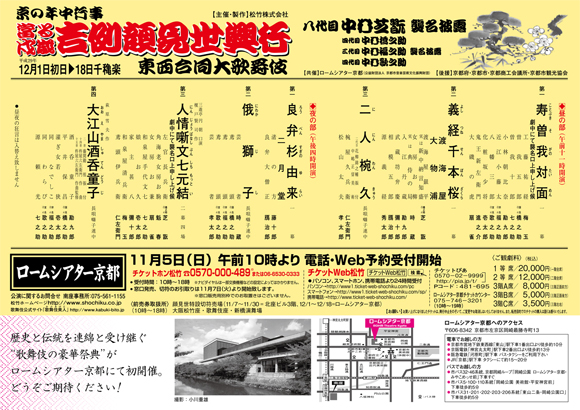 |
| National Theatre (T˘ky˘) |
| Dates | 3 ~ 26 December 2017 |
| Program |
Imay˘ Sanbas˘ |
| Casting |
Living National Treasure Nakamura Kichiemon, Living National Treasure Nakamura T˘z˘, Nakamura Jakuemon, Onoe Kikunosuke, Nakamura Kinnosuke, Nakamura Karoku, Nakamura Matagor˘, ďtani Tomoemon, ďtani Keiz˘, Arashi Kitsusabur˘, Nakamura Kichinoj˘, Nakamura Yonekichi, Nakamura Kash˘, Nakamura Tanenosuke |
| Comments |
Revival of Namiki Gohei I's drama "Suda no Haru Geisha Katagi" (commonly called "Ume no Yoshibŕ"), which was staged for the last time in September 1878 at the National Theatre. The zagashira is Living National Treasure Nakamura Kichiemon.
|
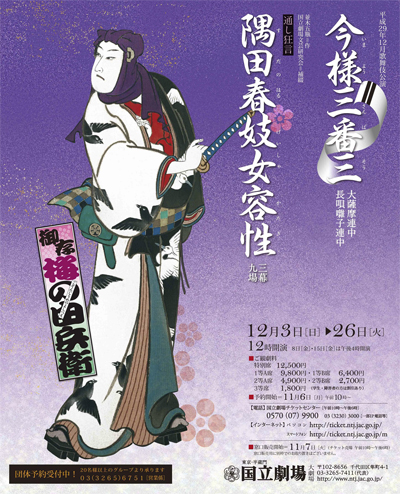 |
| Dates | 22 December 2017 (Dent˘ Kabuki Hozonkai Kenshű Happy˘kai) Training Recital of the Organization for the Preservation of Kabuki |
| Program |
Otanoshimi Zadankai |
| Casting | |
| Comments |
21st Training Recital at the National Theatre produced by the Organization for the Preservation of Kabuki. "Otanoshimi Zadankai" (literally "Enjoyable Roundtable Discussion") is a stage speech with Living National Treasure Nakamura Kichiemon, Living National Treasure Nakamura T˘z˘, Nakamura Jakuemon, Onoe Kikunosuke, Nakamura Kinnosuke, Nakamura Karoku and Nakamura Matagor˘.
|
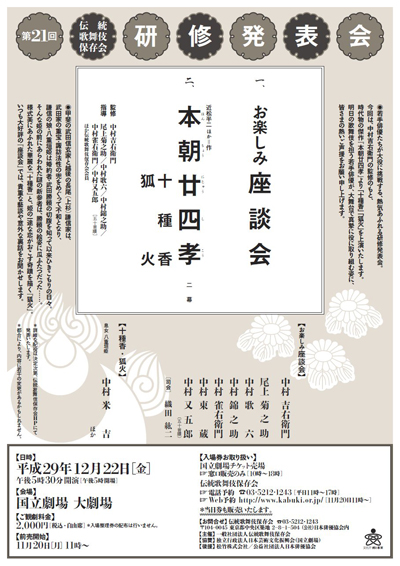 |
| Kabukiza (T˘ky˘) |  |
| Dates | 2 ~ 26 December 2017 (Jűnigatsu ďkabuki) December Grand Kabuki |
| 1st Program | |
| 2nd Program | |
| 3rd Program |
Y˘kihi |
| Casting |
Living National Treasure Band˘ Tamasabur˘, Kataoka Ainosuke, Onoe Sh˘roku, Ichikawa Danz˘, Ichikawa Chűsha, Kataoka Ichiz˘, Kataoka Kamez˘, Ichikawa Monnosuke, Ichikawa Emisabur˘, Kamimura Kichiya, Band˘ Hikosabur˘, Band˘ Kamez˘, Ichimura Manjir˘, Kawarasaki Gonjűr˘, Sawamura S˘nosuke, Nakamura Baishi, Band˘ Shingo, Nakamura Matsue, Nakamura Kotar˘, Nakamura Mantar˘, ďtani Hirotar˘, ďtani Hiromatsu, Ichimura Takematsu, Nakamura Kamenoj˘, Ichimura Kitsutar˘, Kataoka Matsunosuke, Onoe Sakon, Band˘ Kamesabur˘ |
| Comments |
The programs for the December Grand Kabuki at the Kabukiza use the sanbusei tripartite system, which is mainly used in August.
|
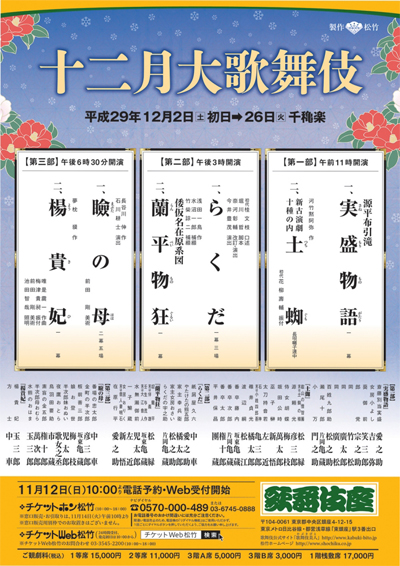 |
|
|||
| Dates | 30 November ~ 2 December 2017 (Zenshinza Nagoya Tokubetsu ~ Chűnichi Gekij˘ Sayonara K˘en) Zenshinza Nagoya Special Performances ~ Chűnichi Theatre Farewell Performances |
||
| Program | |||
| Casting |
Fujikawa Yanosuke, Kawarasaki Kunitar˘, Arashi Yoshisabur˘, Yamazaki Tatsusabur˘, Tadamura Shin'ya, Matsunami Kihachir˘, Tamaura Yűnosuke |
||
| Comments |
Special performances of the Zenshinza troupe in Nagoya at the Chűnichi Theatre. This theater will stop its activities at the end of March 2018 as it is located inside the Chűnichi Building, which will be destroyed and rebuilt due to its old age. The k˘j˘ is about the old performances of the Zenshinza in this theater.
|
||
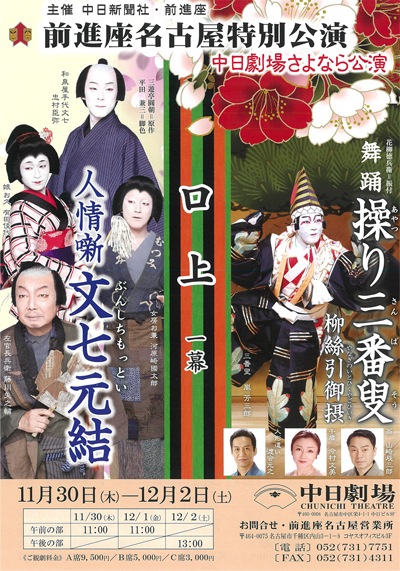 |
| Shunjűza (Ky˘to) |
| Dates | 9 ~ 10 December 2017 |
| First program | |
| Second program | |
| Casting | Onoe Ukon, Nakamura Hayato, Nakamura Tamatar˘, Nakamura Umemaru |
| Comments |
A short Buy˘ program with 4 young Kabuki actors and Buy˘ dancers, under the supervision of the dance master Fujima Kanjűr˘ VIII and Ichikawa Ennosuke. |
|
|
| Contact | Main | Top | Updates | Actors | Plays | Playwrights | Programs | Links | FAQ | Glossary | Chronology | Illustrations | Prints | Characters | Derivatives | Theaters | Coming soon | News |
